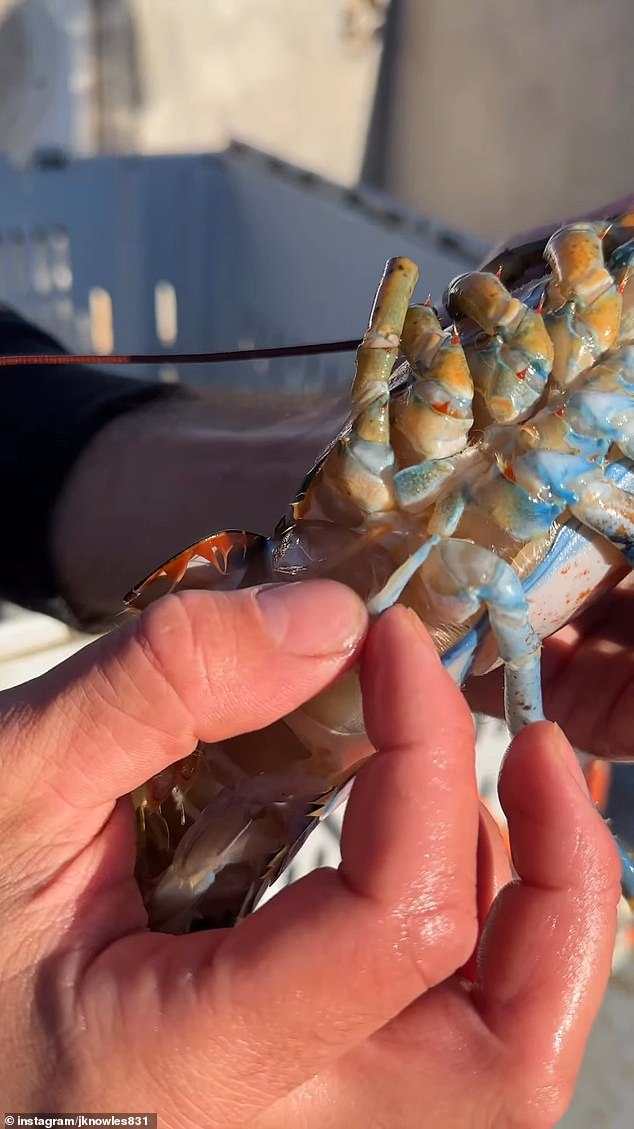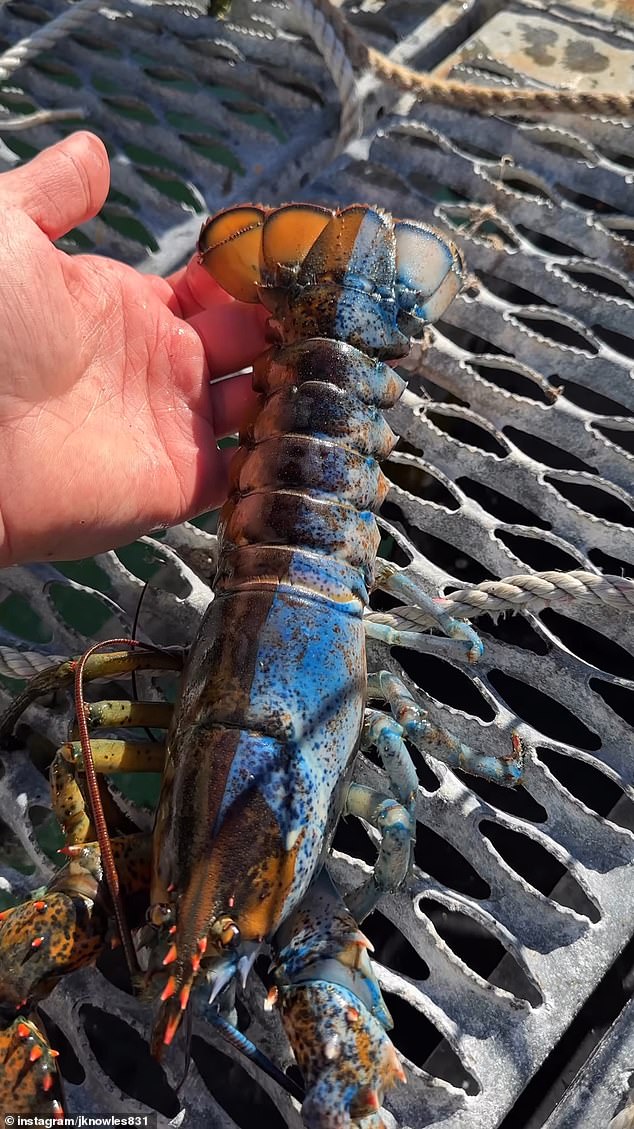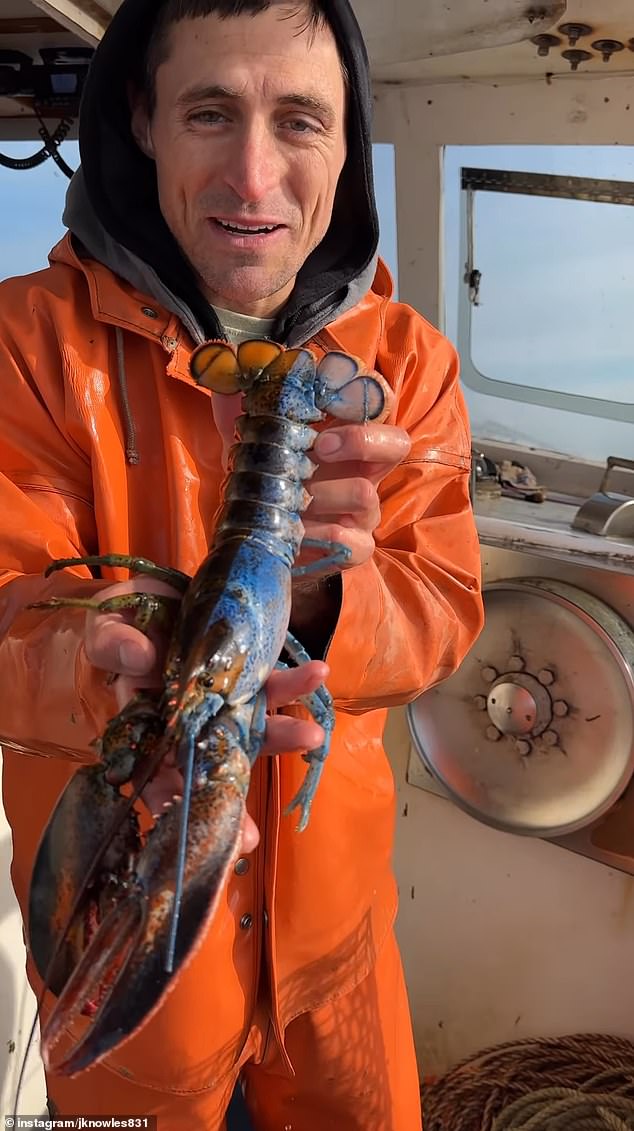‘Trans’ Atlantic! Rare lobster named Bowie found in Maine is two sexes and two colors
>
Maine lobster seems to be worth a lot more as a social media star than if it were served on a roll.
Not only is this unusual animal half blue and half “normal” (orange-brown), but the sides are also of opposite sexes.
Jacob Knowles, who shares his life as a Maine lobster man on social media, has gained nearly 150,000 new followers on Instagram since he posted his first lobster video in mid-November, according to an analysis by Social code.
Knowles and his online followers nicknamed the lobster “Bowie”, a reference to David Bowie’s famous, flamboyant and sexually provocative costumes of the 1970s.
While the rock star is dressed artistically, Lobster Boy displays a trait called “gynandromorphy,” which means he has both male and female reproductive organs.
This type of mutation occurs during the early stages of embryonic development, when an animal’s cells divide for the first time inside its egg.
Lobsterman Jacob Knowles holds a gynandromorph lobster that his friend found in one of his lobster traps
Knowles identified Boy as a gynandromorph by its swimmers, small swimming legs located at the base of the tail.
The male is rigid, but the female is more flexible. These flexible swimmers are covered in tiny hairs that hold the eggs in place when the animal reproduces.
Gynandromorphism has been observed in fossilized crustaceans—the lobster group—as far back as 70 million years ago, and appears to have arisen from some sort of genetic error during these early stages.
It is not uncommon for some species of crustaceans to be hermaphrodites, meaning that they have complete male and female reproductive parts (simultaneous hermaphrodites) or that they switch from one sex to the other in their lifetime (sequential hermaphrodites).
Lobsters are not one of these animals. Male and female lobsters have distinct anatomy.
In addition to the swimmers, the female also has a broader tail that holds the egg clutch underneath.

The blue half of a bowie appears male, and the normal side appears female – as evidenced by the flexible swimmers on the female side, and the tail structures that hold the eggs in place
But because they are crustaceans, scientists think it would be easier for them to become gynandromorphs during early evolution.
Gynandromorphy is not the same as hermaphroditism.
In gynandromorphs, the animal is a “mosaic” of male and female traits, with male and female genetic tissues present throughout.
On the other hand, an intersex animal will appear physically and genetically as entirely male or female, but have some partial sexual anatomy of both sexes.
Some researchers have found evidence of an intersex condition called “ovotestis” in lobsters, in which the male reproductive organs display some of the characteristics of ovaries.
In a case study of a male lobster from 2012, the animal was reported to have Unfertilized egg cells Along with her sperm cells.

The Bowie lobster is almost perfectly split down the middle, with the male reproductive organs on the blue side and the female organs on the other. It is not clear whether Bowie can reproduce on his own
The study’s author suggested that this may be caused by endocrine-disrupting chemicals in the crayfish’s environment.
Some scientists suspect that human pollution may be the reason behind this phenomenon Most common.
What is definitely uncommon is Bowie’s split colors.
But there is some confusion about how rare this phenomenon is, especially since news coverage reports exact numbers.
An oft-cited statistic, attributed to the Lobster Institute at the University of Maine in Orono, says it happens in only about 1 in 50 million lobsters.
Most news stories about Bowie cited this statistic.
But these numbers may need to be updated.
“It’s uncommon, but it’s not uncommon,” Robert Baer, then executive director of the Lobster Institute, told National Geographic in 2015. We see it every year.”
It’s not clear why Bowie ended up this way, but it’s fortunate that he ended up on the Internet and not in someone’s stomach.
Given his size, Bowie could have legally ended up on a silver platter.
according to Maine lawLobster men can keep and sell non-breeding lobsters that are between 3.25 and 5 inches long from their eye to the beginning of their tail.
And Bowie fits that bill.
But who would want to eat this rocky crustacean?

Bowie will live in a barn where scientists will find out if he will be able to reproduce on his own
Knowles describes Boy as “the rarest lobster in the world” because of his combination of rare traits – blue, gynandromorphism, and split color.
Bowie’s sex mutation is certainly unique, but it’s not the first example of a strangely colored crayfish.
In 2010, one was found near East Yorkshire. Named “Harley Quinn” after the colorfully costumed comic character (and Batman villain), this one also had an unusually straight line down its back dividing its two-tone halves.
But unlike Bowie, Harley Quinn’s claws were the opposite color of her body on opposite sides.
Knowles had been keeping Bowie in a cage at the harbor, but after this week’s storm, he decided to bring him to some scientists at the Bar Harbor Oceanarium in Maine, where he would be safer.
(Tags for translation)dailymail
